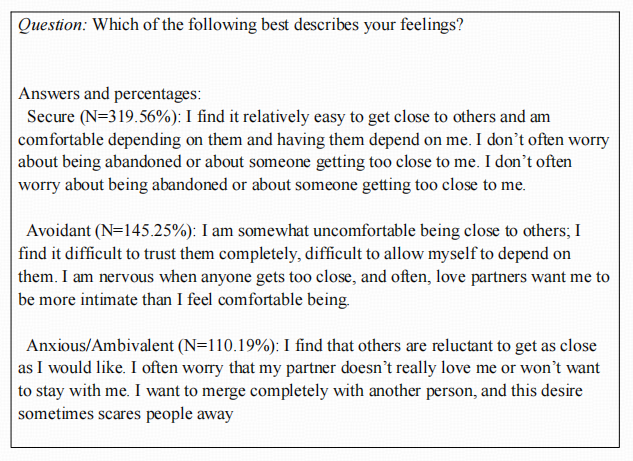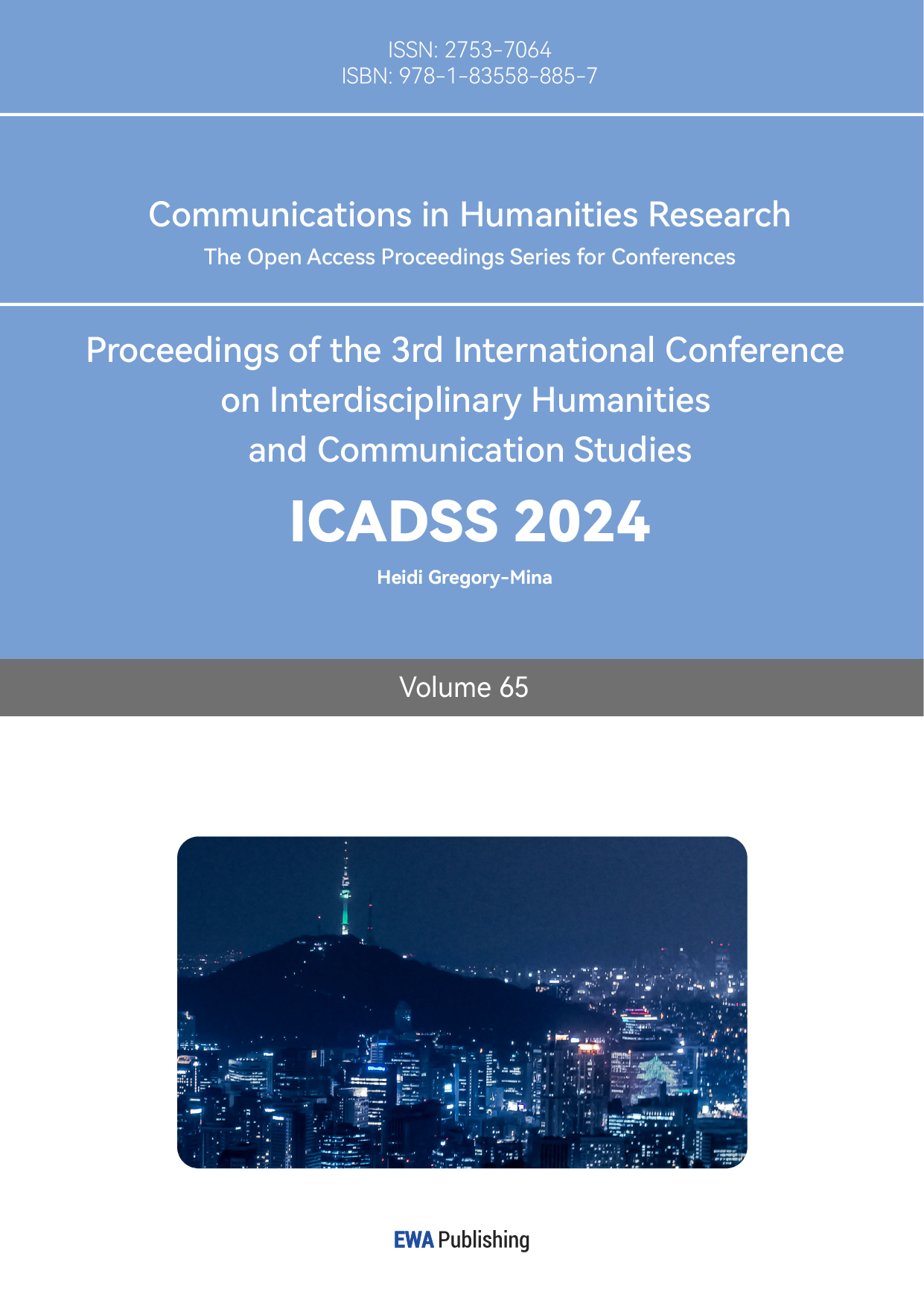1. Introduction
Romantic relationships play an important role throughout people’s life journey, influencing their well-being and social functioning. Attachment theory, developed by Bowlby and Ainsworth [1], explains the emotional bond between infants and primary caregivers and has since been applied to adult romantic relationships. This theory is instrumental in understanding the relational dynamics in the adult romantic relationship, where attachment styles are categorized as secure, avoidant, and anxious/ambivalent. Romantic relationships are extensions of the early childhood attachment process, reflecting the continuity of early attachment experiences. Variety in early developmental processes may lead to different adult relational dynamics of how people approach love, intimacy, and relationship dissolution. This paper aims to explore how different attachment styles impact adult romantic relationship tendencies. By examining the behavioral pattern between early attachment experiences and romantic status, this research seeks to explore how childhood emotional bonds shape the ability to form relational connections in adult romantic life. Research conducted by Hazen and Shaver [2] has explored the link between early attachment and romantic love, finding a continuity of attachment pattern from childhood into adulthood. Also, the study published by Feeney and Noller [3] further examined the association between attachment styles and relationship interactions and stability, shedding light on how attachment influences romantic interactions and dissolution. The implications of the research provide insights for therapeutic intervention to address needs and challenges in the attachment process, helping individuals to develop healthier relationship patterns.
2. Early Childhood Attachment Styles

Figure 1: Adult Attachment Types and Their Frequencies (Newspaper Sample)
As is shown in Figure 1 that early childhood attachment styles exert great influence on adult romantic relationships, which are categorized into three types, namely, secure, avoidant, and anxious/ambivalent. Secure individuals, characterized by intimacy and trust, usually exhibit support and self-worth value in social settings. In contrast, those with an avoidant attachment style tend to demonstrate a reluctance to depend on others, leading to relationships that are often distant and emotionally detached. Additionally, individuals with an anxious/ambivalent attachment style, marked by heightened emotional sensitivity and a fear of abandonment, may display clinginess and insecurity, frequently seeking reassurance from their partners. This paper explores how the variety of attachment styles affects the behavioral pattern in romantic bonds.
2.1. Influence of Childhood Attachment on Adulthood Attachment
Previous research conducted by Sagone, Commodari, Indiana, and La Rosa [4] has established a notable association between attachment style, psychological well-being, and relationship status in adults. Childhood attachment experiences significantly affect individuals’ perception and engagement in the romantic relationship. Throughout the developmental process, people form mental models that learn internalized expectations and observed patterns about others from daily social interactions, and these thinking patterns persist into adulthood. As a result, people with different attachment styles marked by various characterizations will likely form similar behavioral patterns in the romantic bond. Securely attached individuals, during early childhood, typically experience feelings of safety and trust, which foster emotional attunement and comfort in intimate connections. While entering a romantic relationship in adulthood, they exhibit a similar pattern and are more likely to experience stable, long-term relationships accompanied by open communication and high emotional support.
On the other hand, avoidant children deemphasize the importance of relationships, show little emotional response and distance from intimate relationships. In adult romantic relationships, those with an avoidant attachment style often form distant connections marked by reduced happiness and emotional neglect, resulting in withdrawal and commitment crises. An early study on adult attachment by Mickelson, Kessler, and Shaver [5] also discovered that avoidantly attached people struggle to trust and become close to others, which explains their inclination to relational distancing. Moreover, anxious/ambivalent individuals are associated with need and clinginess, lack of trust, and fear of being left alone in the childhood emotional bond. As a result, they are likely to experience intense emotional highs and lows and obsessive preoccupation with their partners, leading to feelings of unfulfillment with high anxiety and insecurity in the relationship.
2.2. Romantic Relationship as Attachment Process
The process of romantic dynamics and relationship dissolution are revealed in the attachment development. Securely attached individuals tend to enjoy long-term relationships, while those with insecure attachment styles often face challenges in maintaining their relationships. Avoidant individuals are more likely to terminate relationships due to fear of intimacy, whereas anxious/ambivalent individuals may struggle to cope with the distress that accompanies separation. These relational dynamics underscore the significant role attachment styles play in shaping romantic experiences. Secure individuals hold positive beliefs in love and self-worth in intimacy, while insecure individuals doubt love and self-value. The mental models established during early childhood exert a lasting influence on the levels of trust and love experienced in romantic relationships.
2.3. Attachment Styles and Romantic Dissolution
Attachment styles influence how individuals experience and perceive relationship dissolution. Avoidant individuals are prone to self-initiated breakups, experience relief rather than distress, and are less likely to aim for a new relationship. On the other hand, anxious individuals often experience the highest level of distress and surprise to break up and initiate a new relationship as soon as possible. At the same time, secure individuals would show mild distress levels and stable relational patterns overall. Different emotional responses to breakup further characterize the three attachment styles. Avoidant people show relief and less distress after relational dissolution, reflecting their tendency to avoid intimacy and distance emotion. Due to the characteristic of distance, avoidant attachment styles predict relationship dissolution because these people are prone to end an intimate relationship and feel relief afterward. A study published by Simpson [6] further explains that avoidant individuals in romantic relationships experience few intense and mild emotions. In contrast, anxious individuals exhibit significant distress following a breakup, highlighting their emotional vulnerability and preoccupation with the relationship.
3. Conclusion
Attachment theory provides a comprehensive understanding on the dynamics of romantic relationships and the lasting impact on emotional bonds on adult behavior. The study conducted by Hazan and Shaver [2] supports the continuity of childhood attachment into adulthood, affecting the quality of romantic relationships. Furthermore, the research done by Feeny and Noller [3] offers valuable insights into how different attachment styles shape individuals’ approaches to handling breakups. These findings enhance awareness of how early childhood experiences and developmental processes play a crucial role in shaping romantic relationships. The implications of this research are particularly relevant in therapeutic settings, where insights can be tailored into therapeutic intervention in helping individuals develop and sustain a healthy intimate relationship. In the future, longitudinal research is needed to explore how attachment styles evolve over time, in response to life events such as marriage, divorce, and parenthood.
References
[1]. Bowlby J. The Bowlby-Ainsworth attachment theory. Behavioral and Brain Sciences. 1979;2(4):637-638. doi:10.1017/S0140525X00064955
[2]. Hazan, C., & Shaver, P. (1987). Romantic love conceptualized as an attachment process. Journal of Personality and Social Psychology, 52(3), 511–524. https://doi.org/10.1037/0022-3514.52.3.511
[3]. Judith A. Feeney & Patricia Noller (1992) Attachment style and romantic love: Relationship dissolution, Australian Journal of Psychology, 44:2, 69-74, DOI:10.1080/00049539208260145
[4]. Sagone, E., Commodari, E., Indiana, M. L., & La Rosa, V. L. (2023, February 24). Exploring the association between attachment style, psychological well-being, and relationship status in young adults and adults-a cross-sectional study. European journal of investigation in health, psychology and education. https://www.ncbi.nlm.nih.gov/pmc/articles/PMC10047625
[5]. Mickelson, K. D., Kessler, R. C., & Shaver, P. R. (1997). Adult attachment in a nationally representative sample. Journal of Personality and Social Psychology, 73(5), 1092-1106. https://doi.org/10.1037/0022-3514.73.5.1092
[6]. Simpson, J. A. (1990). Influence of attachment styles on romantic relationships. Journal of Personality and Social Psychology, 59(5), 971-980. https://doi.org/10.1037/0022-3514.59.5.97
Cite this article
Ouyang,X. (2025). Research on the Role of Attachment Style on the Dynamics of Romantic Relationship. Communications in Humanities Research,65,6-9.
Data availability
The datasets used and/or analyzed during the current study will be available from the authors upon reasonable request.
Disclaimer/Publisher's Note
The statements, opinions and data contained in all publications are solely those of the individual author(s) and contributor(s) and not of EWA Publishing and/or the editor(s). EWA Publishing and/or the editor(s) disclaim responsibility for any injury to people or property resulting from any ideas, methods, instructions or products referred to in the content.
About volume
Volume title: Proceedings of 3rd International Conference on Interdisciplinary Humanities and Communication Studies
© 2024 by the author(s). Licensee EWA Publishing, Oxford, UK. This article is an open access article distributed under the terms and
conditions of the Creative Commons Attribution (CC BY) license. Authors who
publish this series agree to the following terms:
1. Authors retain copyright and grant the series right of first publication with the work simultaneously licensed under a Creative Commons
Attribution License that allows others to share the work with an acknowledgment of the work's authorship and initial publication in this
series.
2. Authors are able to enter into separate, additional contractual arrangements for the non-exclusive distribution of the series's published
version of the work (e.g., post it to an institutional repository or publish it in a book), with an acknowledgment of its initial
publication in this series.
3. Authors are permitted and encouraged to post their work online (e.g., in institutional repositories or on their website) prior to and
during the submission process, as it can lead to productive exchanges, as well as earlier and greater citation of published work (See
Open access policy for details).
References
[1]. Bowlby J. The Bowlby-Ainsworth attachment theory. Behavioral and Brain Sciences. 1979;2(4):637-638. doi:10.1017/S0140525X00064955
[2]. Hazan, C., & Shaver, P. (1987). Romantic love conceptualized as an attachment process. Journal of Personality and Social Psychology, 52(3), 511–524. https://doi.org/10.1037/0022-3514.52.3.511
[3]. Judith A. Feeney & Patricia Noller (1992) Attachment style and romantic love: Relationship dissolution, Australian Journal of Psychology, 44:2, 69-74, DOI:10.1080/00049539208260145
[4]. Sagone, E., Commodari, E., Indiana, M. L., & La Rosa, V. L. (2023, February 24). Exploring the association between attachment style, psychological well-being, and relationship status in young adults and adults-a cross-sectional study. European journal of investigation in health, psychology and education. https://www.ncbi.nlm.nih.gov/pmc/articles/PMC10047625
[5]. Mickelson, K. D., Kessler, R. C., & Shaver, P. R. (1997). Adult attachment in a nationally representative sample. Journal of Personality and Social Psychology, 73(5), 1092-1106. https://doi.org/10.1037/0022-3514.73.5.1092
[6]. Simpson, J. A. (1990). Influence of attachment styles on romantic relationships. Journal of Personality and Social Psychology, 59(5), 971-980. https://doi.org/10.1037/0022-3514.59.5.97









